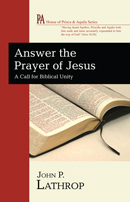The Prayer of Jesus: Our call to unity, by John P. Lathrop

This chapter is from John P. Lathrop’s book Answer the Prayer of Jesus: A Call for Biblical Unity.
The Prayer of Jesus
In John 17 we find the longest recorded prayer of Jesus; the apostle John, under the guidance of the Holy Spirit, included it in his gospel. In fact, it is preserved for us only in John’s gospel. Jesus prayed this prayer just prior to his arrest and subsequent crucifixion. The prayer is very significant for a number of reasons: because it is included in the Scriptures; because Jesus, the Son of God, prayed it; and because of its content. As you read through the prayer you will see that Jesus was anticipating a time of transition, a time when he would be leaving the world and his disciples, to rejoin his Father in Heaven (John 17:11, 13). As this time of transition drew near, Jesus offered up this prayer. In his prayer he made a number of requests; he prayed for himself and he also prayed for his disciples. A quick reading of the prayer will show that the majority of his prayer was given over to making requests for his followers. In this chapter we will focus our attention on the portion of the prayer that he offered for his disciples. This section of his prayer falls into two parts; there is a section given to prayer for the disciples who were present with him in the first century, and a section given to prayer for the disciples who were yet to come. Let us briefly consider each of the parts of the prayer that Jesus prayed for his disciples.
Jesus’ Prayer for His Disciples Who Were Present With Him
In the first part of his prayer for his followers Jesus prayed for the disciples who were present with him (John 17:6–19). As he prayed, he acknowledged the good spiritual qualities in his disciples’ lives. He said that they knew that everything that Jesus had came from the Father (John 17:7), that they accepted the words that Jesus gave to them, that they knew with certainty that Jesus came from the Father, and that they believed that the Father sent Jesus into the world (John 17:8). In short, his disciples had some spiritual perception; this was because they had received divine revelation. One example of this is the Lord’s words to Peter; he told Peter that he was able to make the declaration that Jesus was the Christ because it had been revealed to him by the Father (Matt 16:17). After listing these positive qualities of his followers, which were clear evidence of the work of God in their lives, Jesus moved on to make some requests on their behalf. His requests included prayers for their unity, protection (John 17:11, 15), and sanctification (John 17:17). These requests, at least in part, arose out of Jesus’ concern for his followers. He knew that he was no longer going to physically be with them to help them as he had been in the past (John 17:12), so he asked the Father to minister to them and meet their needs. The disciples had already endured harsh treatment in the world (John 17:14), and they would again as the book of Acts makes clear (Acts 4:1–22; 5:17–40; 8:1–3; 12:1–19). In addition to harsh treatment from people, the attacks of the evil one would be directed toward them as well (John 17:15); these things caused Jesus to intercede for his followers. Jesus wanted his followers to be sanctified, or set apart as God’s people in the world. But Jesus’ prayer for his followers didn’t end there; it went on.
Category: Fall 2012, Ministry, Pneuma Review


